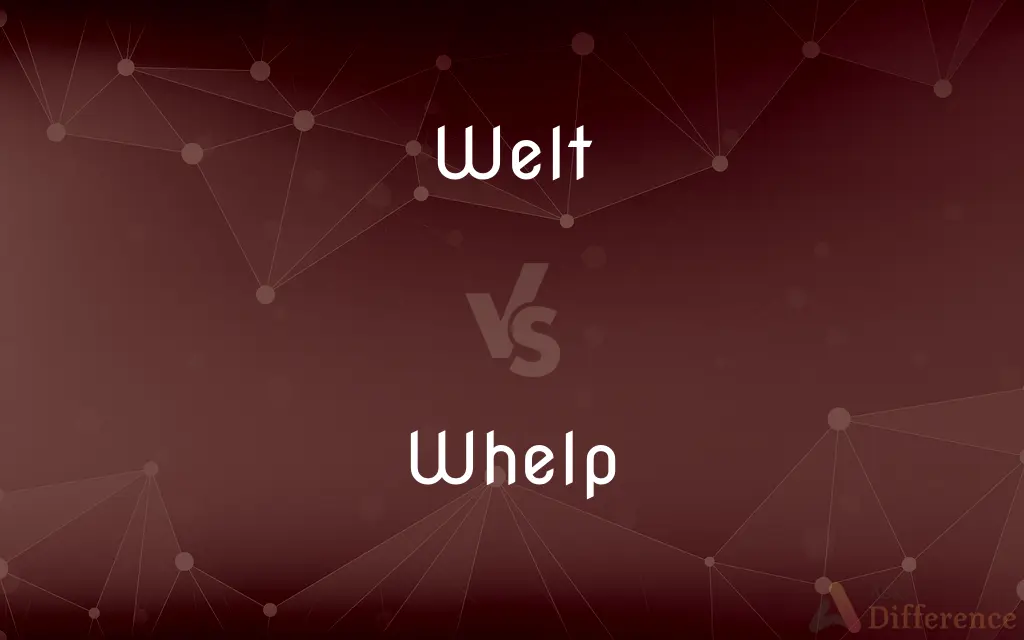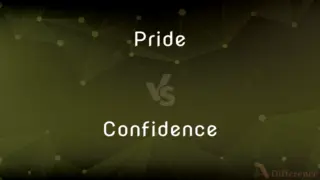Welt vs. Whelp — What's the Difference?
By Tayyaba Rehman & Maham Liaqat — Updated on April 4, 2024
A welt is a ridge or swollen mark on the skin, often from a blow, while a whelp is a young offspring of a mammal, especially a dog or wolf.

Difference Between Welt and Whelp
Table of Contents
ADVERTISEMENT
Key Differences
Welts are physical reactions on the skin surface, caused by an external force or irritation, such as the mark left by a tight elastic. Whelps, on the other hand, refer to the young of certain animals, embodying the early life stage of creatures like dogs, wolves, and occasionally used for young of other species. While welts are associated with pain or discomfort and can appear on any person's skin due to various reasons, whelps signify new life, growth, and the continuation of species.
A welt can also describe a raised or reinforced edge, seam, or strip on fabric or footwear, adding durability or decorative elements. Whelps, conversely, are seen through the lens of biology and animal husbandry, focusing on care, growth, and breeding practices. This distinction highlights the physical versus the biological, with welts enhancing or protecting material objects and whelps symbolizing the nurturing and development of life.
The emotional response elicited by each term varies significantly. Welts are often associated with negative experiences, such as pain, accidents, or deliberate harm. In contrast, whelps often evoke feelings of affection, care, and the joys of new life, emphasizing the divergent emotional landscapes these terms inhabit.
The terminology surrounding each concept varies; welts are discussed in medical, fashion, and material contexts, focusing on causes, treatments, and implications for human health or product quality. Whelps are conversed about in terms of breeding, care, and the emotional bond between animals and humans, highlighting the difference in thematic focus between these terms.
Comparison Chart
Definition
A raised, often painful area on the skin or a reinforced edge on material
A young offspring of a mammal, particularly a dog or wolf
ADVERTISEMENT
Context
Medical, fashion, material durability
Biology, animal husbandry, pet care
Emotional Association
Pain, discomfort, harm
Care, growth, affection
Thematic Focus
Physical reactions, enhancements, protection
New life, development, nurturing
Compare with Definitions
Welt
A mark or effect indicating strong impact or impression.
The movie’s ending left a welt on the audience's emotions.
Whelp
A term in historical texts for young, especially of noble birth.
The knight trained the young whelp in the ways of chivalry.
Welt
A ridge on the skin from a blow or allergic reaction.
The welt on her arm was from an accidental brush against poison ivy.
Whelp
The act of giving birth in dogs.
The breeder said the dog is expected to whelp next week.
Welt
A strip of leather sewn between the insole and outsole of a shoe.
Quality boots have a Goodyear welt for added strength.
Whelp
A young offspring of certain wild mammals.
The wolf whelps were hidden in a den.
Welt
An emotional or psychological mark left by a traumatic event.
The harsh words left a welt on his confidence.
Whelp
Used metaphorically to describe a young, inexperienced person.
The old sailor called the new recruit a whelp.
Welt
A reinforced edge or seam on garments or shoes.
The welt around the shoe’s edge adds to its durability.
Whelp
A newborn puppy.
The golden retriever had a litter of five whelps.
Welt
A leather rim sewn round the edge of a shoe upper to which the sole is attached.
Whelp
A young offspring of a carnivorous mammal, especially a dog or wolf.
Welt
A red, raised mark or scar; a weal.
Whelp
A child; a youth.
Welt
A heavy blow
Let me give it a welt with my hammer
Whelp
An impudent boy or young man.
Welt
Provide with a welt.
Whelp
A tooth of a sprocket wheel.
Welt
Strike (someone or something) hard and heavily
I could have welted him
Whelp
(Nautical) Any of the ridges on the barrel of a windlass or capstan.
Welt
Develop a raised scar or weal
His lip was beginning to thicken and welt from the blow
Whelp
To give birth to whelps or a whelp.
Welt
A strip, as of leather or other material, stitched into a shoe between the sole and the upper.
Whelp
To give birth to (whelps or a whelp).
Welt
A tape or covered cord sewn into a seam as reinforcement or trimming.
Whelp
A young offspring of a canid (ursid, felid, pinniped), especially of a dog or a wolf, the young of a bear or similar mammal (lion, tiger, seal); a pup, wolf cub.
Welt
A ridge or bump on the skin caused by a lash or blow or sometimes by an allergic reaction.
Whelp
(derogatory) An insolent youth; a mere child.
Welt
A lash or blow producing such a mark.
Whelp
(obsolete) A kind of ship.
Welt
To reinforce or trim with a welt.
Whelp
One of several wooden strips to prevent wear on a windlass on a clipper-era ship.
Welt
To beat severely; flog.
Whelp
A tooth on a sprocket wheel (compare sprocket and cog).
Welt
To raise welts or a welt on.
Whelp
To give birth.
The bitch whelped.
The she-wolf whelped a large litter of cubs.
Welt
To roll; revolve
Whelp
Alternative form of welp
Welt
To cause to have welts; to beat.
Whelp
One of the young of a dog or a beast of prey; a puppy; a cub; as, a lion's whelps.
Welt
To install welt (a welt or welts) to reinforce.
Whelp
A child; a youth; - jocosely or in contempt.
That awkward whelp with his money bags would have made his entrance.
Welt
A ridge or lump on the skin, as caused by a blow.
Whelp
One of the longitudinal ribs or ridges on the barrel of a capstan or a windless; - usually in the plural; as, the whelps of a windlass.
Welt
(shoemaking) A strip of leather set into the seam between the outsole of a shoe and the upper, through which these parts are joined by stitching or stapling.
Whelp
One of the teeth of a sprocket wheel.
Welt
A strip of material or covered cord applied to a seam or garment edge to strengthen or cover it.
Whelp
To bring forth young; - said of the female of the dog and some beasts of prey.
Welt
In steam boilers and sheet-iron work, a strip riveted upon the edges of plates that form a butt joint.
Whelp
To bring forth, as cubs or young; to give birth to.
Unless she had whelped it herself, she could not have loved a thing better.
Did thy foul fancy whelp so black a scheme?
Welt
In carpentry, a strip of wood fastened over a flush seam or joint, or an angle, to strengthen it.
Whelp
Young of any of various canines such as a dog or wolf
Welt
In machine-made stockings, a strip, or flap, of which the heel is formed.
Whelp
Birth;
The dog whelped
Welt
(heraldry) A narrow border, as of an ordinary, but not extending around the ends.
Welt
A feature resembling a welt.
Welt
That which, being sewed or otherwise fastened to an edge or border, serves to guard, strengthen, or adorn it
Welt
A narrow border, as of an ordinary, but not extending around the ends.
Welt
A raised ridge on the surface of the skin, produced by a blow, as from a stick or whip; a wale; a weal; as, to raise welts on the back with a whip.
Welt
A blow that produces a welt{3}.
Welt
To furnish with a welt; to sew or fasten a welt on; as, to welt a boot or a shoe; to welt a sleeve.
Welt
To wilt.
Welt
A raised mark on the skin (as produced by the blow of a whip); characteristic of many allergic reactions
Welt
A raised or strengthened seam
Welt
Beat severely with a whip or rod;
The teacher often flogged the students
The children were severely trounced
Welt
Put a welt on;
Welt the shoes
Common Curiosities
How long do whelps stay with their mother?
This varies by species; dog whelps typically stay with their mother until they are about 8 to 10 weeks old.
Can all animals have whelps?
The term "whelp" is primarily used for dogs, wolves, and occasionally other mammals, not all animals.
What causes a welt?
Welts can be caused by allergic reactions, physical blows, or pressure on the skin.
Can welts leave scars?
Usually, welts do not leave permanent scars if properly cared for and not infected.
What materials commonly cause welts in clothing?
Tight elastic bands or rough fabrics can cause welts where clothing rubs against the skin.
Can humans be referred to as whelps?
Metaphorically, yes, particularly to denote inexperience or youth.
Can welts appear for no reason?
Welts can appear due to hidden allergies or stress, not always from an obvious cause.
Is whelping dangerous for the mother?
Whelping can be risky, especially for certain breeds; veterinary supervision is advised.
Are welts dangerous?
Most welts are not dangerous and fade with time, but persistent or severe welts should be checked by a doctor.
How do you treat a welt?
Treatment may include cold compresses, antihistamines, or corticosteroids, depending on the cause.
Are whelps born with their eyes open?
No, canine whelps are born with their eyes closed and usually open them after two weeks.
What is the difference between a pup and a whelp?
"Pup" is a more general term for a young dog, whereas "whelp" can refer to both the act of giving birth and the young themselves.
Why are welts painful?
Welts are often painful due to underlying inflammation and swelling caused by the body’s reaction to injury or irritation.
What is a welt seam?
A welt seam is a reinforced stitch that strengthens the edge of two pieces of fabric.
How can I help a dog whelp?
Ensure a comfortable, quiet space and consult a vet for guidance on care and potential complications.
Share Your Discovery

Previous Comparison
TCP vs. IP
Next Comparison
Pride vs. ConfidenceAuthor Spotlight
Written by
Tayyaba RehmanTayyaba Rehman is a distinguished writer, currently serving as a primary contributor to askdifference.com. As a researcher in semantics and etymology, Tayyaba's passion for the complexity of languages and their distinctions has found a perfect home on the platform. Tayyaba delves into the intricacies of language, distinguishing between commonly confused words and phrases, thereby providing clarity for readers worldwide.
Co-written by
Maham Liaqat














































